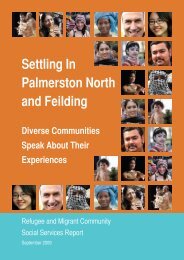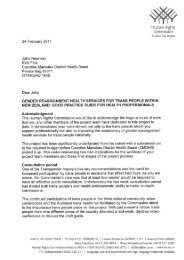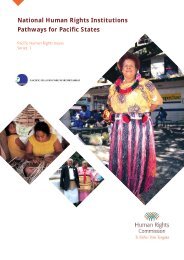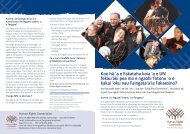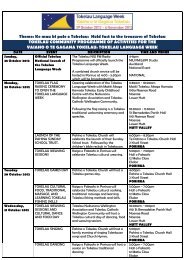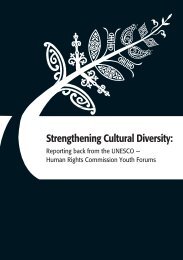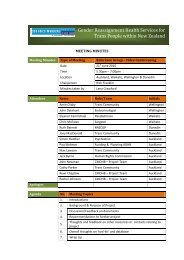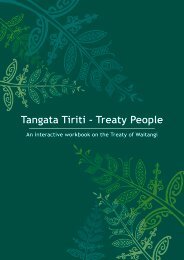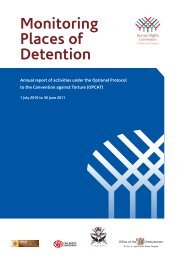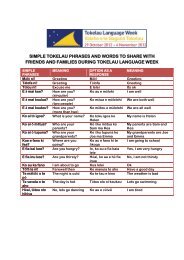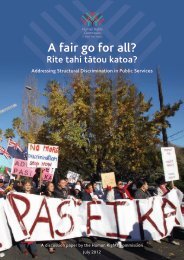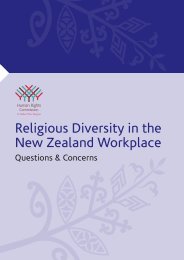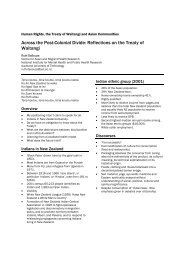Statement of Intent 2013 to 2016 - Human Rights Commission
Statement of Intent 2013 to 2016 - Human Rights Commission
Statement of Intent 2013 to 2016 - Human Rights Commission
Create successful ePaper yourself
Turn your PDF publications into a flip-book with our unique Google optimized e-Paper software.
22 HUMAN RIGHTS COMMISSION | STATEMENT OF INTENTOutcome measuresIn <strong>2013</strong>–14, in addition <strong>to</strong> the impacts and measures se<strong>to</strong>ut within our four outcome areas which relate moredirectly <strong>to</strong> the impact <strong>of</strong> our own work, we will maintaina select number <strong>of</strong> key societal impact measures <strong>to</strong>moni<strong>to</strong>r. Collectively, these societal measures provide anoverview <strong>of</strong> progress <strong>to</strong>wards our desired outcomes. Theseare not intended <strong>to</strong> be comprehensive, but are measuresfrom readily available data <strong>to</strong> help assess the level <strong>of</strong> therealisation <strong>of</strong> civil and political, and economic, social andcultural rights in New Zealand.Where data is available, these measures are disaggregatedacross the population groups <strong>of</strong> people with disabilities,ethnic minorities, women, young people, children, andMäori. There is very little disaggregated data for peoplewith disabilities, limiting the ability <strong>to</strong> develop targetedpolicy from an evidence base.We adopted this set <strong>of</strong> measures in our 2011–14<strong>Statement</strong> <strong>of</strong> <strong>Intent</strong>. The indica<strong>to</strong>rs were drawn from themost recently available data at the time, some <strong>of</strong> whichwere earlier than the 2011 year. The indica<strong>to</strong>rs from the2011–14 <strong>Statement</strong> <strong>of</strong> <strong>Intent</strong> have provided the baselinefor tracking progress.The assessment at the time <strong>of</strong> this <strong>Statement</strong> <strong>of</strong> <strong>Intent</strong> is asfollows:Improvement in the representation and voterparticipation rates in Parliament and local governmentelections disadvantaged groupsFigures from the 2011 General Election showed a slightimprovement in the figures <strong>of</strong> representation in Parliamentfor Mäori (16% <strong>to</strong> 17%) and Pacific peoples (4% <strong>to</strong> 5%)since the 2008 General Election. Asian representationdecreased (5% <strong>to</strong> 4%). 2 The most significant change sincethe General Election voter turnout was the increasedproportion <strong>of</strong> Asian people aged 18 or older who voted,which rose from 60.7% in 2008 <strong>to</strong> 66.4% in 2011. Voterturnout fell for women (from 81.1% <strong>to</strong> 79.8%) and forPacific people (from 74.5% <strong>to</strong> 73.1%) and rose slightly forMäori (74.8% <strong>to</strong> 75%). 3In the 2009 local body elections, Mäori representation inlocal government improved (4.8% <strong>to</strong> 7.4%) with “Other”groups dropping (6.3% <strong>to</strong> 2.1%). 4 Local election voterturnout figures dropped slightly for both Mäori (57.6% <strong>to</strong>56.7%) and female voters (65.2% <strong>to</strong> 64.3%), remainedstatic for Asian voters (52.2%), and increased by 1.5% forPacific people (62.5% <strong>to</strong> 64.1%). 5Increase in rates <strong>of</strong> educational participation andachievementThe percentage <strong>of</strong> school leavers with NCEA Level 2 orabove increased for males (66% <strong>to</strong> 70.9%), females(75.8% <strong>to</strong>77.9%), with rates for Mäori and Pacificpeoples increasing (from 50.4% <strong>to</strong> 57.1% and 62.9%<strong>to</strong> 65.5% respectively) in the years from 2008 <strong>to</strong> 2011. 6Rates <strong>of</strong> achievement for people with disabilities were <strong>to</strong>be measured from a baseline <strong>to</strong> be determined in 2012.However, this measurement has not been undertaken.Decrease in the rates <strong>of</strong> people not engaged in education,employment or training (NEET)Between 2010 and 2012, the NEET rate <strong>of</strong> young peopleaged 15−19 remained relatively steady (increasing slightlyfrom 9.2% <strong>to</strong> 9.6%). For the 20−24 age group, the NEETrate was higher, with a slight increase between 2010 and2012 (17.1% and 18.5% respectively). 7Employment ratesHousehold Labour Force Survey figures in the year <strong>to</strong>December 2012 show a high unemployment rate for youngpeople (15−24 years) at 18.9% compared <strong>to</strong> the overallrate <strong>of</strong> 6.9%. Mäori and Pacific peoples’ unemploymentrates are at 14.8% and 16.0% respectively, followed byunemployment rates <strong>of</strong> 8.0 % and 5.5 % for Asian and2 Source: http://www.parliament.nz/en-NZ/ParlSupport/ResearchPapers/d/c/3/00PlibCIP191-The-2011-General-Election.htm.3 Source: General Social Survey 2010. Relates <strong>to</strong> 2009 local elections.4 Source: Correspondence with Local Government NZ. Response rate was 47.2% <strong>to</strong> the elected members survey. Survey went <strong>to</strong> all elected members in 2011, not justmayors, chairs and councillors as in previous years.5 Source: General Social Survey 2010. Relates <strong>to</strong> 2009 local elections.6 Source: www.dol.govt.nz/publications/lmr/scorecard/feb-<strong>2013</strong>/scorecard-feb-<strong>2013</strong>.pdf.7 Source: Statistics New Zealand Household Labour Force Survey December 2012 Quarter, (released 07 February <strong>2013</strong>) http://www.stats.govt.nz/browse_for_stats/incomeand-work/employment_and_unemployment/HouseholdLabourForceSurvey_HOTPDec12qtr.aspxhttp://www.dol.govt.nz/publications/lmr/quick-facts/youth.asp.



